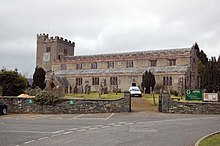Crosthwaite Parish Church
| Crosthwaite Parish Church | |
|---|---|
| St Kentigern's Church, Crosthwaite | |
 |
|
| Location | Great Crosthwaite, Keswick, Cumbria |
| Country | England |
| Denomination | Church of England |
| Churchmanship | Evangelical |
| History | |
| Dedication | St Kentigern |
| Architecture | |
| Status | Active |
| Functional status | Parish Church |
| Heritage designation | Grade II* |
| Designated | 1951 |
| Completed | c. 1181 |
| Administration | |
| Deanery | Deanery of Derwent |
| Archdeaconry | Archdeacon of West Cumberland |
| Diocese | Diocese of Carlisle |
| Province | Province of York |
| Clergy | |
| Vicar(s) | The Revd Stuart Penny |
Crosthwaite Parish Church is a church at Great Crosthwaite on the outskirts of Keswick in Cumbria, England. It is dedicated to St Kentigern and is the Anglican church of the parish of Crosthwaite. Since 1951 it has been a Grade II* listed building. The church has an evangelical tradition.
There has been a church on the site since the 6th century. The present building is largely medieval, with some Victorian internal alterations. Among the vicars of the parish was Hardwicke Rawnsley, co-founder of the National Trust.
The first church at Crosthwaite is believed to have been built in 553 AD under the direction of St Kentigern, who preached the Gospel in the area before moving on to Wales. No records survive of this building, or of its Saxon successor. Both were probably wooden structures. In 1181 Jocelyn of Furness wrote of a new church at Crosthwaite recently built for Alice de Romilly, the Lady of Allerdale. The new church was built of stone and consisted of the nave, a north aisle and a chancel with a chancel arch. There was neither a south aisle nor a tower. The foundations of this structure still exist. In 1189 Richard I gave the rectory of Crosthwaite to the Cistercians of Fountains Abbey. Monks from the abbey worked the parish for the next three hundred years from their base at Monks Hall, which later became the site of Keswick hospital.
During the 14th century (the historians of the church, Tom Wilson and J W Kaye estimate the date to have been about 1340) a chapel was added to the north side of the chancel, and later a south aisle. In the early 16th century there were major changes to the building; the chancel arch was removed, a clerestory was added and existing side chapels were reconstructed. The last important change during the medieval period was the erection of the present tower; the exact date is not recorded.
...
Wikipedia
